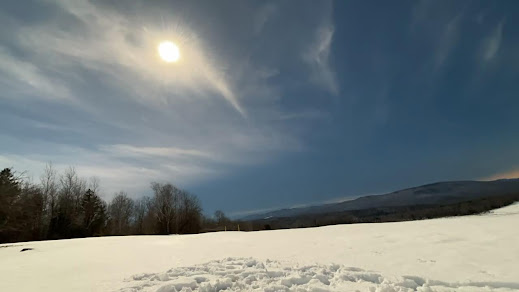Physics Photo of the Week
Eclipse 2024 from Northeast Vermont - Photos
by Olivia Mitchell-Eby
Modern cell phones have the ability to do time-lapse videos, so Olivia supported her cell phone in here lap aimed at the eclipsing sun and recorded the time-lapse video seen below.
This video is amazing. We can see the Moon's shadow projected on the thin cirrus clouds, when the shadow arrives at the viewing point, the sky becomes dark. We don't see the Sun as if it were eclipsed however. Cell phones are "smart" and set the exposures automatically. When the sky turned black from the Moon's shadow, the cell phone automatically adjusts the exposure so that it still records the sky and surroundings. As a result the eclipsed Sun's corona is still over-exposed. This video is amazing because we see the Moon's shadow in the sky approach the observers. When the totality is finished we see the trailing edge of the Moon's shadow approaching "us" until the Sun begins to re-appear and light up the surroundings again.
During totality we can see the planet Venus in the larger image of an individual frame at mid-eclipse in the image below. Venus is visible below and slightly to the right of the Sun. In this image we also see that the Sun is eclipsed (black in its center). The corona - about the brightness of a full Moon - has over-exposed the camera. Observers visually could also see Jupiter to the upper left of the Sun, but that is outside the field of view of the camera.
Weather satellites orbiting the Earth continually take photographs of the Earth from space. The video clip below is made from a series of images taken from a satellite that orbits the Earth in synchrony with the Earth's daily rotation. The Satellite is placed in orbit about 22,000 miles above the Earth's equator. At this distance the Satellite orbits the Earth in exactly one day (24 hrs). The video below is made from a series of images taken from the website: https://weather.ndc.nasa.gov/GOES/ The satellite photos are taken once every 10 minutes. Alternate frames are displayed in this video clip where se see the Moon's shadow projected onto the surface and clouds on the Earth as the shadow essentially transits the full diameter of the daylight part of the Earth in a time span of about 5 hours read from the time stamp on each frame.
(GOES
weather satellite imagery courtesy of the Earth Science Branch at the
NASA George C. Marshall Space Flight in Huntsville, Alabama.)
======================================================================
Physics Photo of the Week is published periodically during the academic year on Fridays by Donald F. Collins, professor emeritus of Warren Wilson College. These photos feature interesting phenomena in the world around us. Students, faculty, and others are invited to submit digital (or film) photographs for publication and explanation. Atmospheric phenomena are especially welcome. Please send any photos to dcollins@warren-wilson.edu.
All photos and discussions are copyright by Donald Collins or by the person credited for the photo and/or discussion. These photos and discussions may be used for private individual use or educational use. Any commercial use without written permission of the photoprovider is forbidden.







Comments
Post a Comment